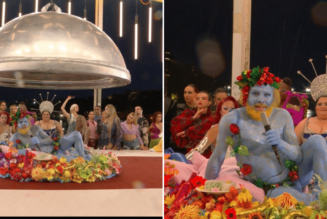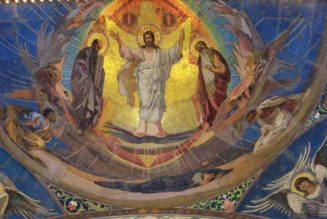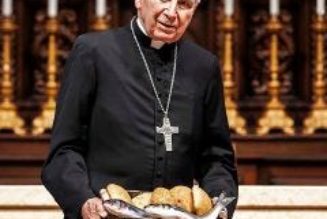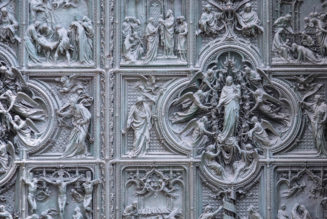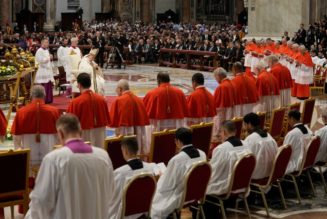, August 12, 2021

Lest we forget what we love about the Catholic Church, the Gospel for this Sunday, the Solemnity of the Assumption of the Blessed Virgin Mary, is here to remind us.
And what we love about the Catholic Church can be summed up in a single word: Mary.
If last Sunday we felt like “poor banished children of Eve … mourning and weeping in this valley of tears,” this Sunday we find once again “our life, our sweetness, our hope.”
The readings for the Assumption closely identify Our Lady with the Church.
In the first reading, from Revelation, John describes a great vision in the sky. In it, the “Ark of the Covenant” quickly seems to become Our Lady of Guadalupe: “a woman clothed with the sun, with the moon under her feet, and on her head a crown of twelve stars,” giving birth to a boy, harassed by a dragon.
Church Fathers see both the Church and the Virgin Mary in this vision. The Fathers also connected Mary, the Ark of the Covenant, with this Sunday’s Gospel in which Mary visits Elizabeth. David went to the hill country of Judah to take the Ark of the Covenant on its journey to Jerusalem; Mary goes to the hill country of Judah to the house of Zechariah, the Temple priest.
“How can the ark of the Lord come into my care?” asks David, and is soon dancing before the ark.
“How does this happen to me, that the mother of my Lord should come to me?” asks Elizabeth, as her child “leaps for joy.”
We can ask the same thing: How have we been found worthy of all the Church has to offer?
The Church is still in the image of Mary in the Visitation. Mary didn’t demand service from Elizabeth; she offered service. This is like Jesus washing his disciples’ feet, only Mary had to take an uphill journey to help Elizabeth.
The Church is doing the same thing today.
“I’ve been to some truly dark places where the suffering would be hard for most Americans to imagine,” former U.N. ambassador Nikki Haley said in 2018. “I’ve been to the border between Colombia and Venezuela, where people walk three hours each way in the blazing sun to get the only meal that they will have that day. Who’s giving that meal? The Catholic Church.”
The Methodist former governor of South Carolina added:
“I’ve been to refugee camps in Central Africa where young boys are kidnapped and forced to become child soldiers and young girls are raped as a matter of routine. Who was in the forefront of changing this culture of corruption and violence? The Catholic Church.”
The incredible story of the Church’s service in our time, from Mother Teresa to your parish’s Loaves and Fishes program, started when Mary set out for Elizabeth’s house in this Sunday’s Gospel.
When Mary comes close, Elizabeth is filled with the Holy Spirit and John leaps in her womb. We experience that too.
Many pregnant mothers have experienced this; a stirring from the child in the womb when they hear their father’s voice again after he has been away — only for Elizabeth and her child it is the presence of the unseen Jesus that does it. Catholics experience this when we happen upon a Catholic Church when we weren’t expecting to, far from home. We feel suddenly energized and taken care of, and the reason is the same: the nearness of the unseen Jesus who is there in the Eucharist.
I love how the Iraqi martyr priest, Father Ragheed Ganni, described the experience of the presence of Jesus Christ in the Eucharist, before his death in 2007.
“The terrorists might think they can kill our bodies or our spirit by frightening us, but, on Sundays, churches are always full. They may try to take our life, but the Eucharist gives it back,” he said. “There are days when I feel frail and full of fear. But when, holding the Eucharist, I say ‘Behold the Lamb of God, behold, who takes away the sin of the world,’ I feel his strength in me. When I hold the Host in my hands, it is really he who is holding me and all of us, challenging the terrorists and keeping us united in his boundless love.”
He met the same Christ who filled Elizabeth with the Holy Spirit and can do the same for us.
In the Gospel for the Assumption, what follows the meeting with Elizabeth is the beautiful hymn of Mary, the Magnificat, which is a celebration of what the Church brings to our lives.
“My soul proclaims the greatness of the Lord; my spirit rejoices in God my Savior,” says Mary.
God’s very nature is to magnify himself, stamping creation everywhere with his image: rocks show his steadfastness and permanence, birds show his beauty and lightness; lions remind us that he is mighty and fearful and lambs remind us that he is meek and mild.
Mary and the Church also magnify the Lord, showing his providence and peace.
“He has cast down the mighty from their throne and has exalted the lowly,” Mary says.
Apply this to the Church.
The names of the Church’s wicked self-seekers are either forgotten, intentionally, out of embarrassment, or kept alive mainly in news archives of scandal stories. In Dante’s Inferno they are cast down from their thrones, stuck in the muck of their eternal shame: The popes, bishops, priests and religious who marred the beautiful Church with their own ugliness, along with the Catholic lay people who heard the truth all their life and undermined it out of cowardice or for money, honor, pleasure or power.
The Church’s poor are the real heroes; those who are humble and accept God’s truth get thrones in heaven. They are remembered in the gratitude of those they touched, or in the Church’s calendar, and they are lifted on high in translucent radiance in Dante’s Paradiso and as guiding lights in the Purgatorio. There you will find St. Lawrence who insisted that the Church’s real treasure was its poor, lame, and sick — and was killed for it; St. Francis, who appeared in rags and bothered the conscience of the pope; and St. Lucy, the martyr who saw Jesus by allowing her eyes to be torn out for him.
“His mercy is from generation to generation; to those who fear him,” Mary says.
Here is the true sweetness of the Church. She is the place our sins are taken away, the place where we emerge from the confessional as if from the Church’s own womb, reconfigured and made new, filled with the “peace on earth and good will toward men” that we were promised when the angels broke out in song on the day Jesus Christ was born.
Ultimately, the faithful will receive in mercy what Mary received in her Assumption, when the Church teaches that “the Most Blessed Virgin Mary, when the course of her earthly life was completed, was taken up body and soul into the glory of heaven.”
As the Catechism puts it, “she already shares in the glory of her Son’s Resurrection, anticipating the resurrection of all members of his Body.” As Sunday’s Second Reading puts it: “In Christ shall all be brought to life, but each one in proper order: Christ the firstfruits; then, at his coming, those who belong to Christ.”
Our whole life is a pilgrimage to one day join “the queen arrayed in gold” in heaven. That is why we repeat over and over our plea for ourselves and the whole Church: “Holy Mary, Mother of God, pray for us sinners, now and at the hour of our death.”
Image: Heidi de Vries, Flickr, Assumption.
Tags: Assumption of the Blessed Virgin Mary, prayer, Sunday Gospel, Sunday Readings
Never miss a post! Subscribe below to our weekly newsletter.
Related
Join Our Telegram Group : Salvation & Prosperity

